#norwegian history
Text

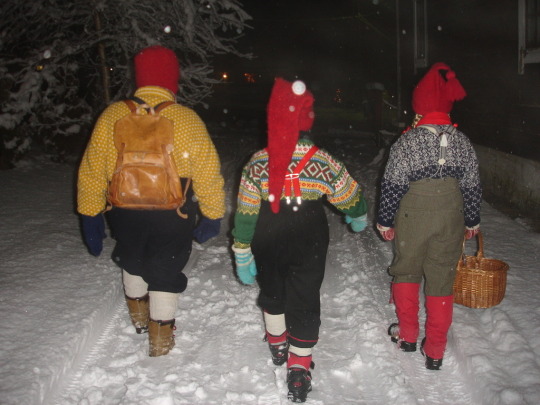
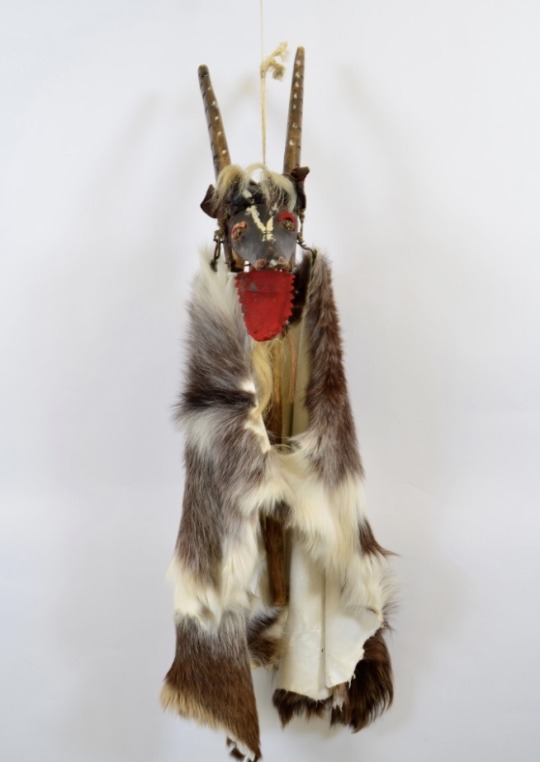
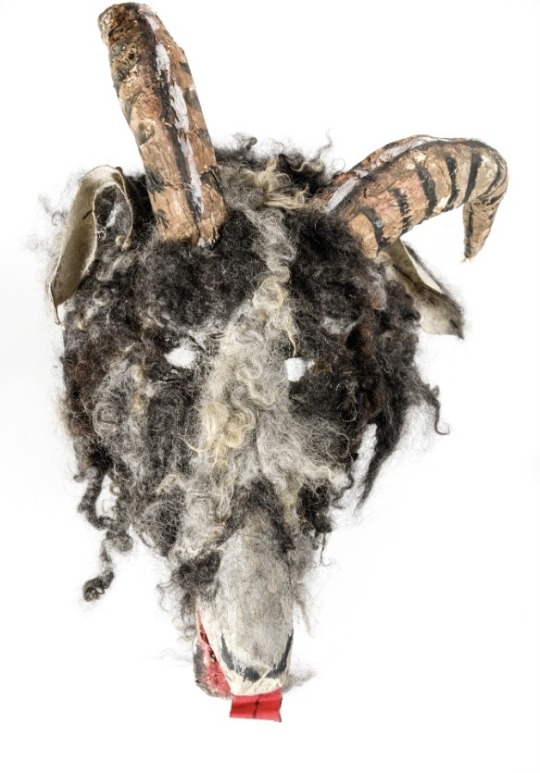



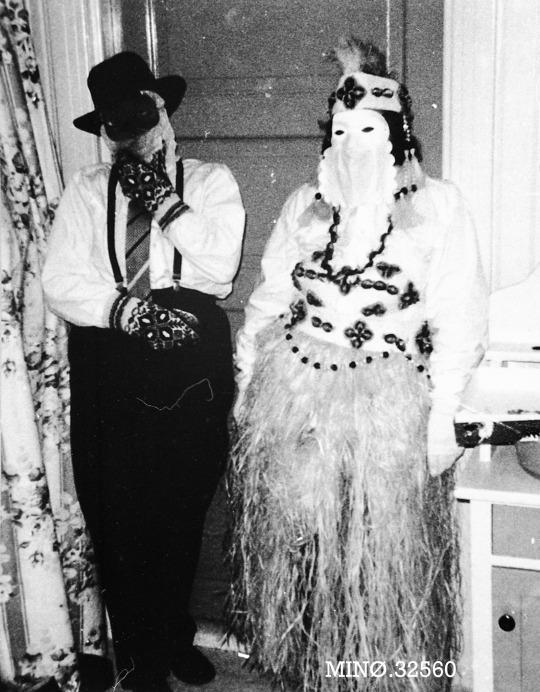


Julebukk/Julegeit
In the time after christmas especially kids & teens (at least now) would dress up in masks, go door to door and sing for food, bevrages and snacks. In the old times the ones who dressed up would sing for leftovers such as christmas cookies. If they got christmas decorations they would brawl like animals. Some also say it was used to scare kids.
This is a long tradition in the nordics, and can be traced back to 1546, Sunnmøre, Norway.
The tradition is not christian and can be traced back to the middle ages. The tradition has roots in norse traditions, but has gained some christian roots too.
#norway#bunad#norge#culture#norwegianculture#culturenorway#traditional#norwegian#bunadstakk#vintagenorway#norwegian town#norwegian history#norwegian clothes#nordic culture#culturalwear#cultural shoes#cultural wear#cultural clothing#cultures#tradtional wear#traditional clothes#traditional clothing#traditions#norwegian traditions#christmas traditions
60 notes
·
View notes
Text

Portrait of Siguard Scott Hansen sitting on a chair, wearing a fur lined hooded parka, a pair of trousers, and smoking a pipe. Printed by: Wesleyan Sunday School Union. Taken in 1895 in an arctic region. Source: The British Museum, Asset Number 706112001.
#arctic#pipemen#pipesmoking#vintagemen#retro men#historic photo#pipes#smoking pipe#handsome#norway#norwegian#norwegian history#polar explorers
36 notes
·
View notes
Text
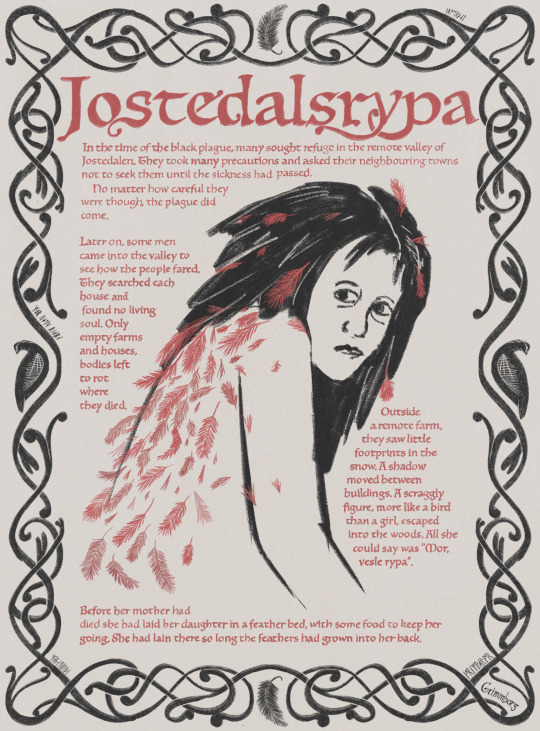
Jostedalsrypa
or The Grouse of Jostedal
As a child obsessed with the plague and disease, Jostedalsrypa was always one of my favourite tales. The utter devastation of society, as well as a girl turned wild bird, really caught my imagination.
Although the real Jostedal was not wiped out during the Black Death, Norway as a whole was devastated. Many towns and farms were entirely abandoned, and some farms remained empty for around 300 years.
In the time of the black plague, many sought refuge in the remote valley of Jostedalen. They took many precautions and asked their neighbouring towns not to seek them until the sickness had passed. No matter how careful they were though, the plague did come.
Later on, some men came into the valley to see how the people fared. They searched each house and
found no living soul. Only empty farms and houses, bodies left to rot where they died.
Outside a remote farm, they saw little footprints in the snow. A shadow moved between buildings. A scraggly figure, more like a bird than a girl, escaped into the woods. All she could say was "Mor, vesle rypa".
Before her mother had died she had laid her daughter in a feather bed, with some food to keep her going. She had lain there so long the feathers had grown into her back.
#black death#jostedalsrypa#plague#middle ages#fairy tale#my art#runes#norwegian history#can the name rjupa/rypa please make a comeback#also yes i left out the ending bc thats just family legend building and idc about that lol#ptarmigan#grouse
14 notes
·
View notes
Text
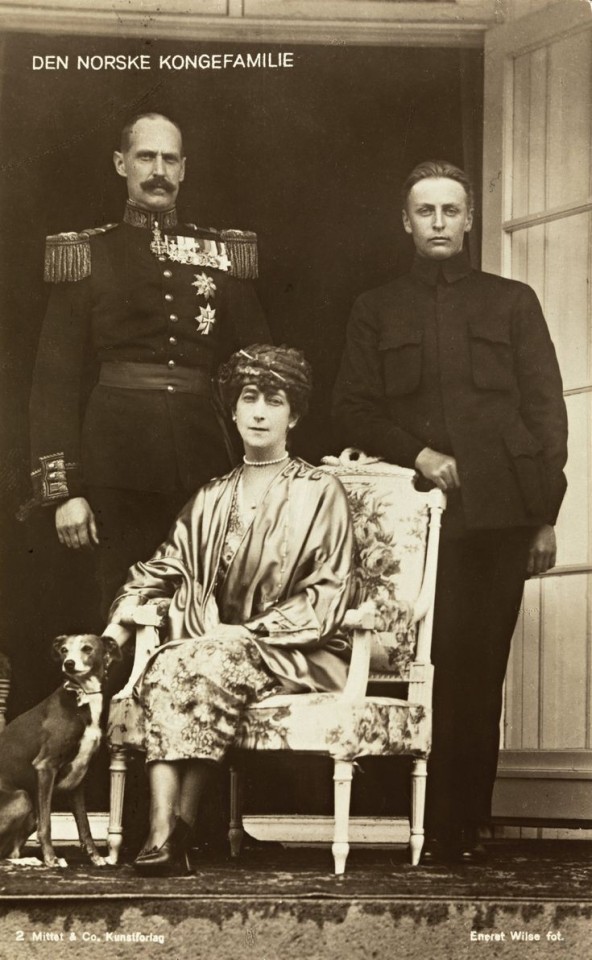
The Norwegian Royal Family:
King Haakon VII of Norway, Queen Maud, Crown Prince Olav and their whippet.
#king haakon vii of norway#queen maud of norway#king olav v of norway#norwegian royal family#norwegian history#house of glücksburg
22 notes
·
View notes
Text
February 7, 2024 || Crown Princess Victoria inaugurated Nordiska museet's new exhibition Nordbor. Nordbor is Nordiska museet's largest exhibition ever and tells the story of life in the Nordics for 500 years. The exhibition focuses on 22 real people from throughout history to provide an understanding of similarities and differences over time. The new exhibition stretches through the entire top floor of the museum and contains approximately 4,000 objects spread over 27 rooms. The exhibition opens to the public on February 10.
#swedish royal family#crown princess victoria#nordiska museet#240207#swedish history#finnish history#norwegian history#danish history#icelandic history#sápmi
5 notes
·
View notes
Text
The Vikings & Norse Mythology Book Collection
The Lost Book Archive charges $15 for this collection. If you found this roundup helpful, please consider donating to the Internet Archive instead.
Mythology by Edith Hamilton (1942)
The Long Ships by Frans G. Bengtsson (1941)
(Ed note: this is a rental; I cannot find a public domain version)
The Broken Sword by Poul Anderson (1954)
The Prose Edda: Tales by Norse Mythology by Snorri Sturlusson, Jesse Byock (1220)
East o' The Sun and West o' The Moon - P. C. Asbjornsen (1921)
The Poetic Edda: Stories of the Norse Gods and Heroes (Unknown)
The Poetic Edda - H. A. Bellows (1923)
Germania by Tacitus Tacitus (AD 98)
Myths of Norsemen: Retold from the Old Norse Poems and Tales by R.L Green (1960)
(Ed note: this is a rental; I cannot find a public domain version)
Myth and Religion of the North: The Religion of Ancient Scandinavia by E.O.G. Turville-Petre (1964)
Myths of the Norsemen from the Eddas and sagas by H. A. Guerber (1908)
The Story of Rolf and the Viking's Bow - A. French (1904)
An Elementary Grammar of the Old Norse or Icelandic language - G. Bayldon (1870)
The Road to Hel: A Study of the Conception of the Dead in Old Norse Literature (1968)
Heimskringla: The History of the Kings of Norway by Snorri Sturluson (1230)
In the Days of Giants; a Book of Norse Tales by A. F. Brown (1902)
Asgard Stories - Tales from Norse Mythology - M. H. Foster (1901)
The Children of Odin - P. Colum (1920)
Norse Mythology Or The Religion Of Our Forefathers Containing All The Myths Of The Eddas By: R. R. Anderson (1875)
The Nine Books of the Danish History of Saxo Grammaticus Vol. 1 and 2 - S. Grammaticus (1905)
A Handbook of Norse Mythology Hardcover by Karl Andreas Mortensen (1913)
The Perfect Wagnerite - a commentary on the Niblung's Ring - B. Shaw (1912)
The Nine Worlds - Stories from Norse Mythology by M. E. Litchfield (1900)
The One-Eyed God: Odin and the (Indo-)Germanic Männerbünde by Kris Kershaw (2000)
The House of the Wolfings and all the Kindreds of the Mark - W. Morris (1888)
Bulfinch's Age of Fable or Beauties of Mythology (1855)
Asgard and the Gods by W. Wagner (1902)
Teutonic Myth And Legend - D. Mackenzie (1921)
Teutonic Mythology Vol. 1 by J. Grimm (1835)
Teutonic Mythology Vol. 2 by J. Grimm (1835)
Teutonic Mythology Vol. 3 by J. Grimm (1835)
Teutonic Mythology Vol. 4 by J. Grimm (1835)
Beowulf and The Fight at Finnsburg by F. Klaeber (1922)
Beowulf; an introduction to the study of the poem with a discussion of the stories of Offa and Finn by R. W. Chambers (1921)
The Kalevala - The epic Poem of Finland Vol. 1 and 2 - J. M. Crawford (1904)
Manual of Mythology - Greek and Roman, Norse, and old German, Hindoo and Egyptian mythology - A. S. Murray (1875)
Laxdaela Saga - translated from the Icelandic by Muriel A.C. Press (1899)
Myths of Northern Lands, narrated with special reference to literature and art by H. A. Guerber (1895)
The Heroes of Asgard - Tales from Scandinavian Mythology by A. Keary (1908)
Norse stories retold from the Eddas by H. W. Mabie (1900)
Kalevala, the land of heroes Vol. 1 & 2 - W. F. Kirby (1907)
The viking age the early history, manners, and customs of the ancestors of the English speaking nations Vol.1 by P. B. Du Chailu (1889)
The ethical world-conception of the Norse people by A. P. Fors (1904)
The Heimskringla or, Chronicle of the kings of Norway Vol. 1 - S. Laing (1844)
The Heimskringla or, Chronicle of the kings of Norway Vol. 2 - S. Laing (1844)
The Heimskringla or, Chronicle of the kings of Norway Vol. 3 - S. Laing (1844)
Viking Tales - J. Hall (1902)
12 notes
·
View notes
Text
Queer history in Norway
I'm mostly going to be translating one wiki, but this will be a quick overview over queer history in Norway. Mainly to motivate myself to read it, but ask for clarification if I phrase things weirdly. This is pretty much an uncritical translation, I'll probably look further into a couple of these things.
Summary:
while being gay wasn't favored, there were no homophobic laws before christianity came (1170). Over the years one could become an outlaw or be burned at the stake for gay sex. You weren't always punished though, because they didn't want to talk about it. In 1781 there was a marriage between two people who were afab, one who lived as a man, possibly trans (possibly bigender). In 1814 Norwegians got our constitution.
In the 1900's there were "romantic friendships" and "peppermø" (ace/unmarried) culture. World world two happened. In 1972 being gay was no longer criminalized. From 1948 there were a couple queer organizations, who in the end turned into the one known as Fri - organisasjonen for kjønns- og seksualitetsmangfold (Free - the organization for gender/sex and sexuality diversity). It became illigal to discrimiate against gay people in 1981. In 1993 gay people could become partnered, but not adopt nor marry in the church. In 2008 gay people could marry.
Since 2010 no "perversions" have been recognized as mental illnesses (homosexuality from before, fetishes, sadomasochism, transvestism etc.). Since 2012 you haven't been able to send gay asylum seekers back to homophobic countries. 2022 was queer culture year (skeivt kulturår). A ban on conversion therapy is in the works, it's only not out-right supported by KRF (who want to make it more difficult to transition) and FRP (who appear not to care either way). A third gender is going to be introduced legally.
translation note:
I don't know all the nuances of slang for sex, especially not historically, so I'm calling anything that seems like it could be sex sex, I'm including the words so you can do your own research, some may mean getting romantically involved I have no idea. Another thing is that sometimes things are about any non heterosexual orientation (e.g. bisexual, asexual) and the original text just says gay (homofile), then I'll just say gay, it is known as an umbrella term, so maybe it works, idk. Some things may also apply to trans people, but they're rarely mentioned.
Lokal Historie Wiki: Skeiv Historie (queer history from a wiki):
The first time homosexuality is mentioned in history is before christianity came here. Gay men were called feminine and bitches, which was very derogatory. Society seemed to be against them, but we don't know of homophobic laws.
When christianity came laws against homosexuality were made, in year 1170. It was inexcusable, one became an outlaw for having gay sex. ("Um to karmenn blandar seg med kvarandre").
In 1687 with Christian Vs norske lov (norwegian law) you could be burned at the stake for anal sex (sodomy). Not many were punished like that because people didn't want to talk about it in case it inspired more gay sex.
in 1781 a trans guy and a (cis) woman got married. Labels were different, but if he lived like a guy I'll call him a guy.
In the 1800's there were more words for gay "tvitotling", "tvetulle" (two tools), which has been used for intersex (tvekjønna) animals was used to describe people who trancended gender/ broke gender/sex norms (kjønnsoverskridende). Another word was "båing" (both), used about gay men and lesbian women. There are some signs of society not being exclusively negative towards queerness.
In 1814 we got "one of the most progressive constitutions in the world". Also, a university student had to quit his studies and leave the city after being outed as gay, but not legally punished. And people were aware of the Greek society being more accepting of homosexuality/sexuality.
In 1842 Christian Vs norske lov (norwegian law) was superseded by community service or prison time. Having gay sex (incl. lesbian) was called "against nature" ("omgjengelse mot naturen") and still punished. In 1846 three girls were punished for having lesbian sex, one with 1,5 years of community service and two with 15 days of prison with only bread and water. In 1847 they were found not guilty. In 1854 they were convicted for outrageous behavior ("forargerlig oppførsel") instead of unnatural sex.
(1886). Gay men on the other hand had to leave their university and got a lot of drama when people learned they were gay. New term: "kontrærseksualitet" (contrary/deviant sexuality). The idea of "sexual perversion" entered the psychiatry. The "I was born this way"-argument (født sånn-argumentet) got introduced. People thought kinks, fetishes and being gay was caused by masturbation, mental illness or negative external impulses (unsure what the last one means). And people still thought it was contagious.
In 1902 (straffeloven) being gay was further criminalized. Paragraph 213 banned "utugtig omgjøngelse" (lewd/undisiplined sex) between men. Gay men were basically told to be discreet as the law was to be put in to action when it was of concern to the general public (allmenheten). It was completely legal to discriminate towards gay men on the job and hosing markets because being gay was illigal.
Several women in the 1900's lived together in what was called "romantic friendships". Some of these may be percieved as platonic and not everyone in them called themselves lesbians. "peppermø" (literal: pepper maiden) was an unmarried woman over 30 and they were of many orientations, especially many who today probably would have called themselves asexual. They were a community or culture that broke with the heteronormative/heteroamatonormative society, because women were according to norms supposed to get married as early as possible.
1924: Alf Martin Jæger wrote gay fiction, homosexual (homoseksuell) was used for the first time in fiction. 1932: The doctors Karl Evang and Torgeir Kasa wrote an article saying people were born gay and deserved human rights (which was radical at the time). In 1937 a lesbian identity was described in "Følelsers forvirring" (feeling's confusion/the confusion of emotions) by Borghild Krane, and she talked about a demand of marriage for security.
WWII came. The nazis sent gay people to consentration camps with a pink triangle, which has later in time become an important symbol of gay people's struggle and gay visibility as a minority. The Norwegian nazi party (Nasjonal Samling) wanted to make paragraph 213 stricter but didn't succeed. People in gay relationships with Germans could be punished by German (Nazi) law.
In 1949 we got the first gay organization, a local branch of the Danish Forbundet av 1948 (Organization of), but it only lasted half a year. In 1950 Det Norske forbundet av 1948, DNT-48 (The Norwegian Organization of) with Rolf Løvaas as its leader. It became independent from the Danish Forbund av 1948 in 1963. They fought against the paragraph 213 (straffeloven § 213), but also for informing people and solidarity amongst gay people.
In 1961 the first Norwegian trans man (Aker sykehus) and in 1962 the first Norwegian trans woman (Rikshospitalet) got a gender affermative operation.
In 1965 the first gay radio program aired (on NRK). The Norwegian [university] Student's orgnization discussed gay people's situation. And in 1966 FTPN, a trans rights organization, was established, it became independent in 2000 and changed name in 2014 (FTPN still).
In 1972 paragraph 213 was repealed. Kim Friele was at the forefront of this (she died in 2021).
In 1975 Lesbisk Bevegelse (Lesbian movement) was founded. Since DNT-48 had a strong focus on gay men people wanted a lesbian, feminist organization.
In 1966 Åpen kirkegruppe was founded to fight for gay christians. In 1976 Arbeidsgrupper for homofil frigjøring, AHF (working groups for gay liberation) came.
In 1977 being gay was no longer a mental illness according to Norsk Psykiatrisk Forening. In 1982 the state, sosialdepartementet also removed homosexuality as a diagnosis.
There was some in-fighting, so in 1979, to unite everyone Fellesrådet for homofile og lesbiske organisasjoner i Norge, FHO (the common/joint council for gay and lesbian organizations in Norway) was made.
In 1981 paragraph 135a and 394a gave protection for gay people. These paragraphs, though most known as the racism paragraphs (rasismeparagrafene), protect from discrimination based on sexual orientation. They protect from discrimination in employment and housing. Later gay people came the work environment law (arbeidsmiljøloven) in 1998 and 2005.
In 1983 Helseutvalget for homofile (the health committee for homosexuals) was founded. The HIV-epidemic had come, and it affected gay men especially, though it did affect other people as I'm sure everyone knows. It increased stigmatisation, people were calling it "a punishment from God" (protestant christian). In 1987 came Landsforening mot AIDS, LMA (country wide). Kirkens bymisjon (christian organization, does a lot of good stuff) opened Aksept (accept) the first center for HIV-positive people and those sick with AIDS. In 1988 AIDS or HIV was not a valid reason for firing someone. The same year Pluss (plus) was founded for those with HIV. In 1999 LMA and Pluss became one, eventually turning into HivNorge (who, in addition to their HIV stuff, today support a couple of queer organizations)
In 1992 Landsforeningen for lesbiske og homofile (The National Association for Lesbians and Homosexuals) was made from the combination of DNF-48 and Fellesrådet for homofile. Later they expanded their name to add bisexuals and trans people. Since 2016 they've been called Fri - foreningen for kjønns- og seksualitetsmangfold (Free - the organization for gender/sex and sexuality diversity).
In 1993 the partnership law was passed. It let lesbian and homosexual couples have mostly the same rights as heterosexuals through marriage. But they could not adopt nor get married in the church. With religious freedom in mind they didn't instruct the church to change their way. In 2008 a new marriage law came, which made gay (incl. lesbian) people allowed to marry.
Skeiv ungdom was founded in 2004. Skeivsnuen anselag was founded in 2006 as a continuation of Drangeleik (danish, boy game). Oslo fagottkor (fagott isn't a slur in Norwegian, but it's based on the english) was founded in 2004.
In 2010 no "perversions" were any longer recognized as mental illnesses (homosexuality from before, fetishes, sadomasochism). Since 2012 you haven't been able to send gay asylum seekers back to homophobic countries. A ban on conversion therapy is in the works, it's only not out-right supported by KRF (who want to make it more difficult to transition) and FRP (who appear not to care either way). A third gender has been introduced legally.
In 2008 the state made an action plan titled "better life quality for lesbians, gats, bisexuals and trans people". Then the LGBT (LHBT) center was made in 2011 as a knoweledge center from sexual orientation and gender identity. In 2015 Skeivt arkiv (queer archive) was opened. They belong to the University in Bergen (UiB).
2022 was queer culture year (skeivt kulturår). The pride of 2022 there was a shooting at a gay bar in Oslo and Oslo Pride was cancelled.
Further reading:
Tone Hellsund: Currently alive researcher at the university in Bergen who among other stuff has written about "peppermøsamfunnet" (non-partnering women). (bora.uib.no). (ethnologist specialized in gender studies).
Alf Martin Jæger: "Odd Lyng" (gay fiction) in 1924.
Borghild Krane: "følelsers forvirring" (lesbian fiction) in 1937
FRI - foreningen for kjønns- og seksualitetsmangfold.
More organizations (my post of links)
Bergen Open Research Archive. Free to read. Has (among other things) queer studies. Some is in Norwegian, some in English.
queer rights today on Wikipedia
#skeive greier#queerblogging#queer history#norwegian history#norwegian queer history#lgbt#lgbtq history#gay history#norskblogging#13435
43 notes
·
View notes
Text
Petronelle Nielsen (1797-1886) was a lesbian woman from Ringerike in Norway.
In diaries from 1824-1830 she wrote about girls from the neighbouring farms who she fell in love with, some of them returning her feelings, and about the acceptance, love and support she received from her family. She and another woman, Dorthea Wretmann, moved inn together in 1834 and lived together the rest of Petronelle's life.
Petronelle was educated as a painter and was one of the first women in Norway to be myndiggjort (the best translation I could find was "coming of age").
The Norwegian Nathional Library has digitised these six diaries, which are available in their online database.

Here's an article from the Norwegian national broadcaster (in Norwegian):
25 notes
·
View notes
Text

Day 10: Eva Nansen!
Eva Helene Sars was born in Oslo, Norway, to a prominent family; her father was a priest and professor, and under her mother’s influence the family home became a noted academic salon. Eva herself was drawn to the arts; she was a gifted singer, and debuted in 1881 as a concertic mezzo-soprano, singing to crowds across Europe.
As was conventional, her public singing career ended with her 1889 marriage to arctic explorer Fritjof Nansen, a scientist and daredevil known for his long-distance skiing and eventual traverse of the Arctic Sea with the Fram expedition. They met at a ski resort, when Fritjof helped Eva up after a fall, and despite Fritjof’s frequent absences, the couple had five children.
Skiing was a controversial hobby for women at the time. Women’s sports were on the rise, heavily associated with the women’s rights movement, and Eva fought to popularize the sport for women; she attended one event, the Husebrynnet ski jump, alongside activist Cecelie Throresen Krog. In 1892, Eva and Fritjof skied across Norway’s Hardangervidda plateau, Eva in a practical but scandalously short ski dress the couple had designed together.
4 notes
·
View notes
Text


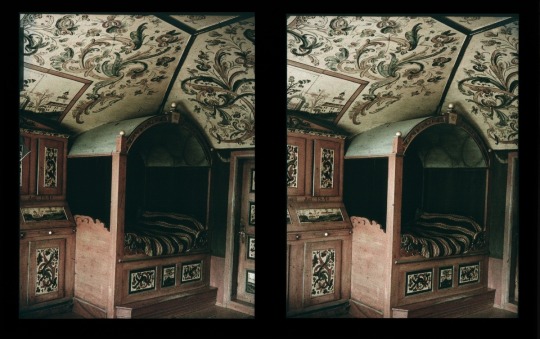
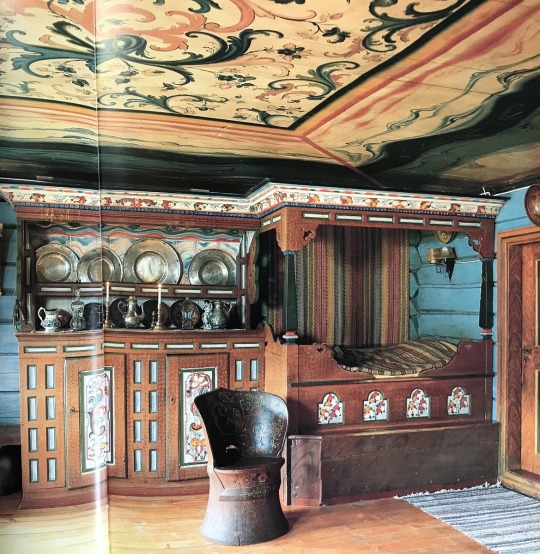
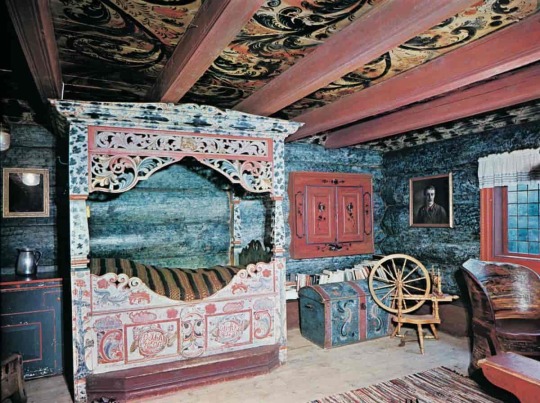
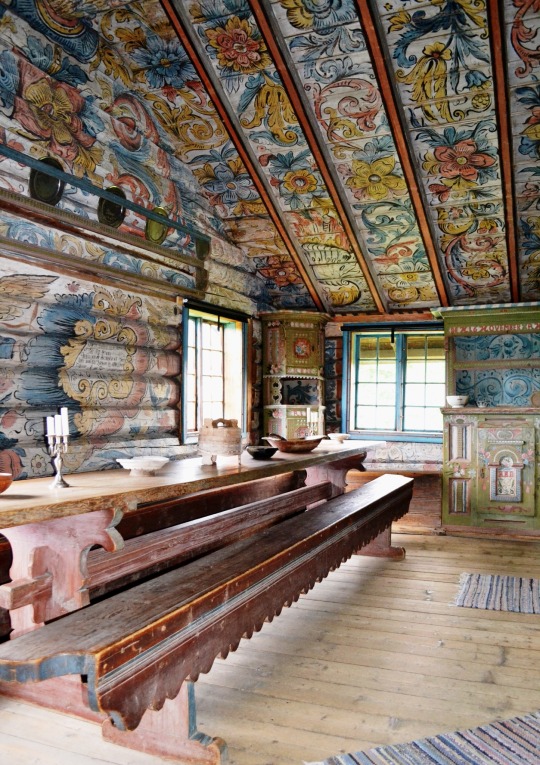
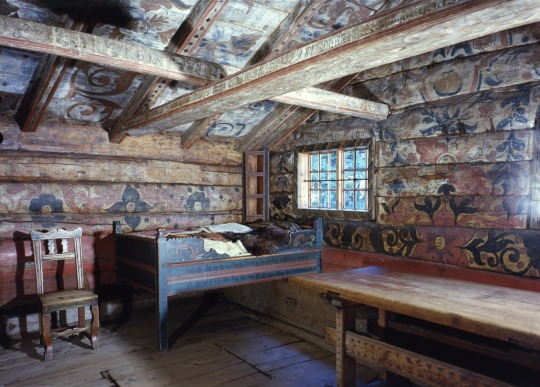
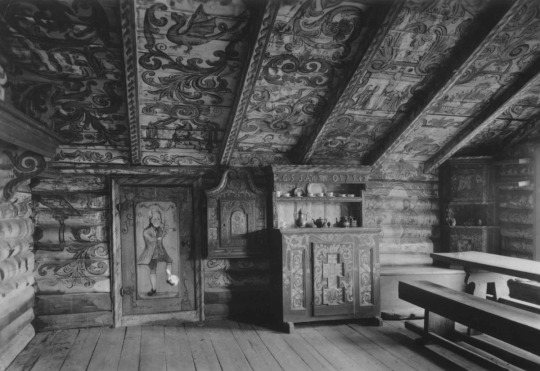
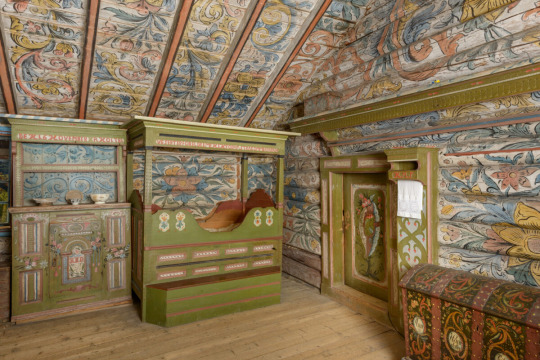

Rosemaling (Norwegian art form)
Rosemaling can be painted on anything, mostly we see it on objects such as cake boxes, chairs, cabinets etc.
Here you can see the traditional art form on walls, roofs & beds. During this time, rosemaling is quite common in norwegian houses, but mostly for smaller objects. However a while back the art form was also used to decorate houses, curches, cabins etc.
#norway#bunad#norge#culture#norwegianculture#culturenorway#traditional#norwegian#bunadstakk#vintagenorway#norwegian house#cultural art#nordic culture#cultures#cultural#rosemaling#norwegian history#norwegian art#painting#telemark#traditions#traditional art#traditional design#traditional painting#nordic traditions
69 notes
·
View notes
Text
norwegian queer history archive
available in both norwegian and english
has tons of information abt queer history and the gay liberation movement in norway, theres lots abt important people, various organizations and things such as drag and gay bars
28 notes
·
View notes
Text

The Moose petroglyph from Åskollen, Drammen.
Estimated to be around 6500 years old.
#moose#drammen#elg#petroglyphs#petroglyph#illustration#archeology#ancient civilizations#norwegian history#stone age#helleristninger#bergkunst#viken#holocene#neolithic#archaeology#grimmborg#flat
193 notes
·
View notes
Text
Norwegian bridal crown, 19th century
10 notes
·
View notes
Text
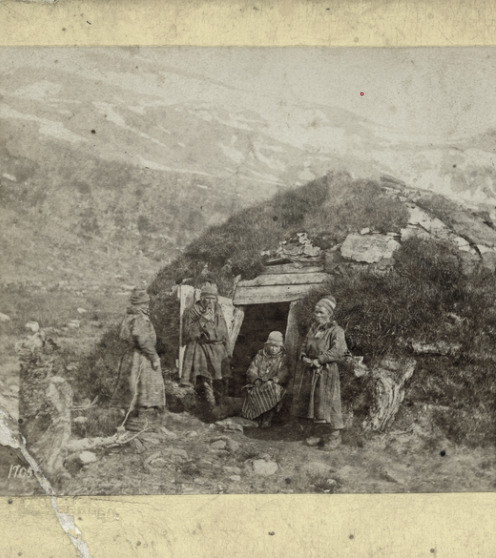
Sámi family outside of a Goahti/Gamme, Tromsø, Norway
Foto: Knud Knudsen, Valdres Folkemuseum
#upload#sámi#sàpmi#tromsø#indigenous people#norway#norwegian history#vintage norway#knud knudsen#goahti#norge#saami
3 notes
·
View notes
Text
You know.
It’s not that I do not care at all about Viking era Norwegian history. Or mythology. I do, it is cool and facinating part of our history. The fact that they recognized that confession during torture was legally invalid, and women had rights to divorce on such valid grounds as «my husband is not pretty enough.»
And a running gag a friend of mine and I got is that I am courting Skadi.
It is just. Two issues with this time for me.
First of all a lot of people, treat Norwegian history as. Viking era, turn to Christianity, owned by Denmark, given to Sweden, independence, now. Maybe people might mutter about Birkebeinerne, mistaking them as Vikings. Or the Black Plauge. Possibly even say things they remember about the witch trials, which were some of the worst in all of Europe.
A lot of these people treat the viking era as the best thing about us. Like a Golden Age that we lost.
Which leads me into the second part.
Lot of people are real fucking weird about the Vikings. Either because they have strange ideas that this was a time and people free of «globalism» which is. So funny when you consider that there were muslim vikings and what they plundered and traded.
Then it’s the people who has ideas of vikings being uwu soft bois who did not participate in slavery and «the Christians were presenting them as bad but they weren’t 🥹»
Which is equally exhausting. Both camps are presenting them in a way that lacks nuance and do not see them the way they were. You can hardly escape either camp when you dip into the waters of viking history and mythology.
Besides, there are many periods of our history and folklore that is equally interesting. We are more than just the viking era. Both good, bad and the VERY bad.
2 notes
·
View notes
Text

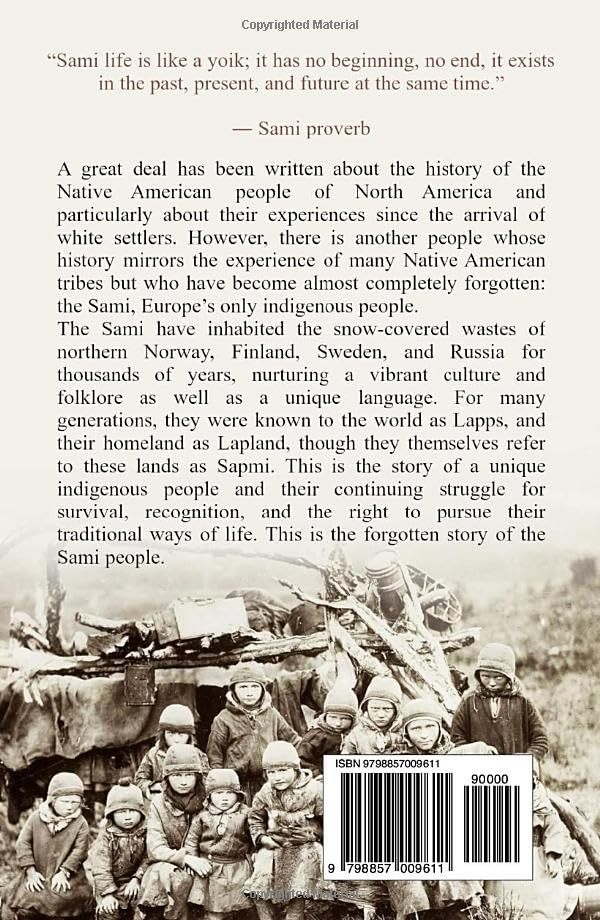
I just finished putting together October's post where I go through some of all the history books published throughout the month. It will go up tomorrow afternoon. One book that's not mentioned in the post but that I wanted to highlight anyway is Sami People: A History from Beginning to Present by Hourly History. It was published at the beginning of October, but since it has no real author & I can't verify that it's written by a historian, another type of scholar, or a journalist, I didn't feel it was right to feature it. However, since it's very rare that us Sámis get acknowledged internationally & have books written about us like this, it also felt wrong to not talk about it. You see my struggle here? So, I want to encourage people to check it out but, at the same time, use critical thinking when reading!
#literature#sápmi#sámi#indigenous people#native people#history student#swedish history#norwegian history#finnish history#russian history#affiliate links
8 notes
·
View notes